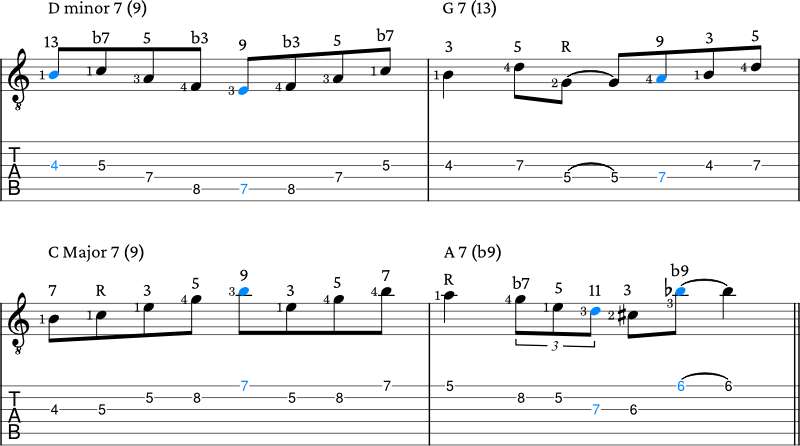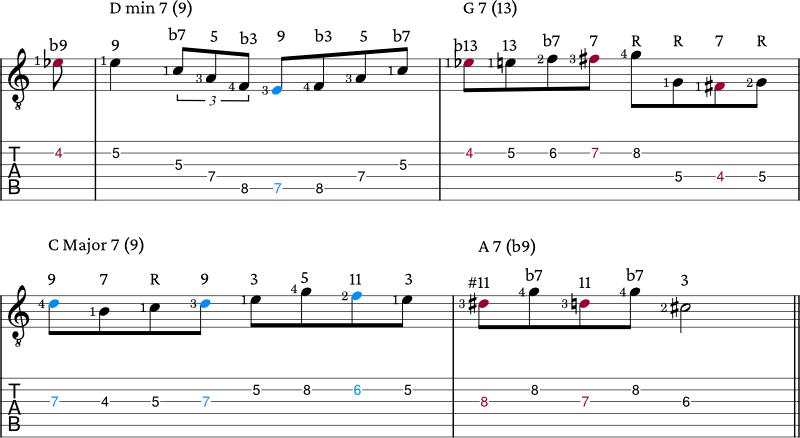If you’re looking to level up your solos and really nail improvising over chord progressions, using chord tones is one of the best ways to make your playing sound smooth and musical.
Chord tones are simply the foundational notes within any chord such as the root, 3rd, 5th, and sometimes the 7th. Think of these as your musical landmarks: when you use them, your solos naturally flow with the chord changes, giving your playing a stronger, more melodic sound.
Before we dive into practical examples (including guitar tabs and audio), let’s quickly cover some essential music theory. This way, you’ll clearly understand how chord tones work and why they’re such a game-changer for your improvisation skills.
✨ This PDF is included free with Pro Membership
Chord Tones Explained
Chord tones are the notes that give chords their unique sound or “color.” In other words, they’re the notes that clearly define what a chord actually is. Usually, when musicians talk about chord tones, they’re referring to notes like the root, 3rd, 5th, and sometimes the 7th of a chord.
These notes match up with intervals or scale degrees, which just means how far each note is from the chord’s root.
Here’s a chart to show you exactly how intervals relate to chord tones:
Chord Tones Chart
| Interval | Chord Tone |
|---|---|
| Unison | Root |
| minor 2nd | flat 2 or b2 |
| Major 2nd | 2 |
| minor 3rd | flat 3rd or b3 |
| Major 3rd | 3 |
| Perfect 4th | 4 |
| Augmented 4th | sharp 4 or #4 |
| Perfect 5th | 5 |
| minor 6th | flat 6 or b6 |
| Major 6th | 6 |
| minor 7th | flat 7 or b7 |
| Major 7th | 7 |
| minor 9th | flat 9 or b9 |
| Major 9th | 9 |
| Major 11th | 11 |
| Augmented 11th | sharp 11 or #11 |
| Major 13th | 13 |
Chord Tones in Triad Chords
Here are some examples of chord tones for triad chords:
- Major chord – 1, 3, and 5. For example, C Major has the chord tones C, E, and G.
- Minor chord – 1, b3, and 5. For example, C minor has the chord tones C, Eb, and G.
- Diminished chord – 1, b3, and b5. For example, C diminished has the chord tones C, Eb, and Gb.
Chord Tones in 7th chords
Now, here are some examples of chord tones for common 7th chord qualities:
- Major 7 chord – 1, 3, 5, and 7. For example, C Major 7 has the chord tones C, E, G, and B.
- Minor 7 chord – 1, b3, 5, and b7. For example, C minor 7 has the chord tones C, Eb, G, and Bb.
- Dominant 7 chord – 1, 3, 5, and b7. For example, C 7 has the chord tones C, E, G, and Bb.
- Minor 7 b5 chord (aka half diminished) – 1, b3, b5, and b7. For example, C half diminished has the chord tones C, Eb, Gb, and Bb.
- Diminished 7 chord – 1, b3, b5, bb7 (same as Major 6). For example, C diminished 7 has the chord tones C, Eb, Gb, and A.
If needed, check out how to play these essential 7th chords on guitar.
Take a look at the following sample chord progression and then we’ll go over how to practice and apply using chord tones on your instrument.
Chord Progression Example
The chord progression we’ll use for the following examples is D minor 7 (9), G 7 (13), C Major 7 (9), and A 7 (b9).

Targeting Chord Tones
Now that you know what chord tones are, the next step is to find exactly where they are on your instrument. Knowing how to quickly find these notes will dramatically improve your solos, because you’ll confidently land on notes that fit perfectly with each chord.
We’ll use the sample chord progression to target each chord tone. The charts below include guitar tabs, but these exercises can be applied to other instruments.
To start things off, let’s focus on hitting the root notes of each chord.
Targeting Root Notes

Targeting 3rds

Targeting 5ths

Targeting 7ths

These examples are just one way to find and practice chord tones. For the best results, try this exercise in different spots around the fretboard. The more areas you explore, the better you’ll understand your instrument and the easier it’ll be to improvise freely.
Keep in mind, your actual solos won’t sound exactly like these exercises. Instead, think of them as a tool to sharpen your awareness of where the key notes are located when chords change.
Now, let’s take this concept to the next level by introducing arpeggios.
Chord Tone Arpeggios
Once you’re comfortable finding individual chord tones, the next step is to connect them by playing full arpeggios. This means playing all the chord tones in a chord (one at a time) so you can really get to know how each chord sounds and feels on your instrument.
In the example below, we’ll play through each chord using arpeggios. This not only helps you visualize the notes better, but also builds a strong foundation for creating more melodic and intentional solos.
Chord Tone Arpeggios – Ascending
The scale degrees are labeled above the notes to help you see how each note relates to the chord. Root notes are marked as “R.” The fretting hand fingering suggestions is added beside the notes.

Chord Tone Arpeggios – Descending
You can also practice the same arpeggios but in descending patterns like this:

Chord Tone Arpeggios – Ascending / Descending
You can also try mixing the direction of the arpeggio patterns in every measure like this:

You can also experiment with different variations like alternating between descending and ascending patterns or skipping notes within an arpeggio to keep things interesting and challenge your fretboard awareness.
Most of the chord tone arpeggio examples were starting on the root note but you can also start these on the 3rd, 5th, and 7th chord tones.
To learn more, check out how to play Major 7 arpeggios, Dominant 7 arpeggios, minor 7 arpeggios or half diminished arpeggios on guitar.
Using Chord Tones to Create Smooth Voice Leading
Now let’s take it a step further and learn how to connect your phrases more smoothly using chord tones. This technique is called voice leading, and it helps your solos flow naturally from one chord to the next.
You can create smooth voice leading by moving between chord tones in small steps, especially half steps or by using notes that stay the same between chords. These subtle movements make your solos sound more intentional and melodic, rather than just jumping randomly between notes.
For example, here are some common notes between the following chords:
- D minor 7 and G 7 share the chord tones D and F.
- G 7 and C Major 7 share the chord tones G and B.
- C Major 7 and the A 7 share the chord tones E, and G.
Voice Leading Example 1
These smoothly connected notes are called guide tones. They highlight the harmonic movement between chords and give you a clear path for creating melodic, flowing lines in your solos.

Melody Example 1 (Only Chord Tones)
We’ll use the same guide tones from the previous example to build a simple melodic idea.

Voice Leading Example 2

Melody Example 2 (Adding Scale Notes)
Keep in mind that when playing over 7th chords, some scale degrees are often referred to as extensions. These are notes that go beyond the basic chord tones, adding more color to your sound. Here are a few common ones:
- The 2nd becomes the 9th (a step above the octave)
- The 4th becomes the 11th
- The 6th becomes the 13th
Scale notes are highlighted in blue.

Voice Leading Example 3 (Using Extensions)
You can even use chord tone extensions as a way to create smooth transitions between chords. For example:

Using Approach Notes
Once you’re comfortable with chord tones, you can spice things up by using approach notes:
- Chromatic approach: Play one fret above or below the target note
- Diatonic approach: Use a note from the scale leading to the chord tone
Example:
- Target note: G
- Approach: F# (below chromatic), A (above diatonic)
You can also use two notes before targeting a note, whether from below, above or both.
This technique create a sense of build-up and release, which makes your soloing sound more musical and expressive.
Melody Example 3 (Using Approach Notes)
Measure 4 doesn’t directly approach the chord tone but uses two chromatic notes to lead into the 3rd of the chord. Chromatic notes are labeled in red and scale approach notes in blue.

Think Like a Composer
Improvising isn’t just about running up and down scales but more like creating phrases that sound musical in the moment. Here are some tips to sound more musical:
- Develop motifs (repeat and vary ideas)
- Leave space (don’t play nonstop)
- Use dynamics and phrasing
- Experiment with rhythm (i.e. don’t always start on beat 1)
- Use scale patterns to generate ideas
Writing Out Chord Tones
One of the best ways to internalize chord tones is by writing them out. Take a chord progression or song you’re learning, write down the changes, and fill in the chord tones or simple melodic ideas. Then, practice playing them on your instrument.
You can use something like the My Music Composition Notebook (with printable sheet music and guides), or a free tool like Musescore to input notes digitally.
This exercise not only helps you see the notes more clearly but also strengthens your understanding of music theory.
One of my music teachers suggested this exercise, and I used to keep a notebook filled with chord tone and scale ideas. Mapping out lines for different progressions really helped me connect the theory to my playing.
You can do this even when you’re away from your instrument.
Backing Track 🎶
Want to practice playing over the backing track in this lesson?

✨ This PDF is included free with Pro Membership
Wrapping Up
Learning to think in chord tones is a powerful way to bring more clarity and purpose to your improvisation. I encourage you to try these exercises over different progressions you enjoy and challenge yourself by playing in a variety of key signatures.
The more you practice and review chord tones, the quicker you’ll recognize them across the fretboard. Keep experimenting with the ideas we covered: targeting specific notes, playing arpeggios, connecting phrases with guide tones, and writing things out. These small steps will add up and make a big difference in your playing over time.
If you enjoyed this, you may also want to check out:
📘 Get the free guitar practice guide here!
Best,
JG Music Lessons
Start Playing Better, Faster
with Pro Membership! ✨
Get the guidance, tools, and support that keep your progress on track:
🏁 Always know what to practice next. Access the full Guitar Learning Roadmap with lessons in sequence.
🎼 Play songs with confidence. Step-by-step lessons of popular, classical pieces and other styles.
📙 Save time and frustration. Clear PDFs and ebooks that save time so you can focus on playing.
🎟️ Get rewarded for consistency. 2 free downloads every month (a $240+ yearly value).
🎁 Keep costs low while you grow. 50% off all charts, tracks, and posters — up to 75% off bundles.
🚫 Stay focused. Ad-free environment keeps you in the zone.
💬 Get help when you need it. Direct member support to keep you on track.


